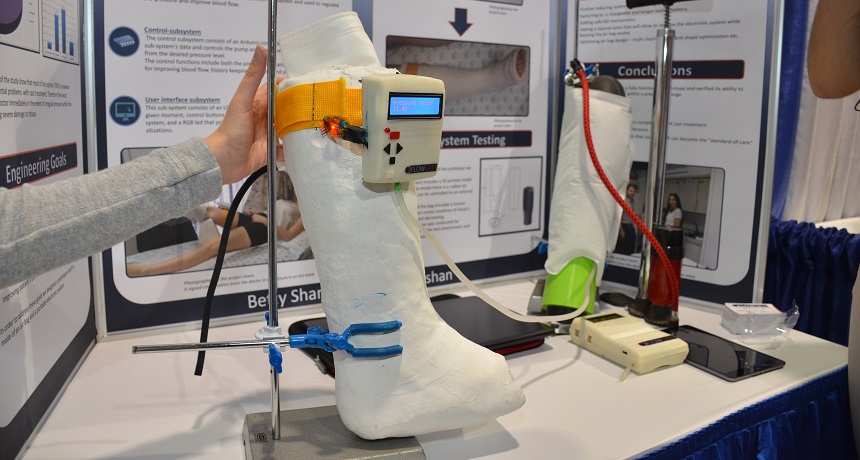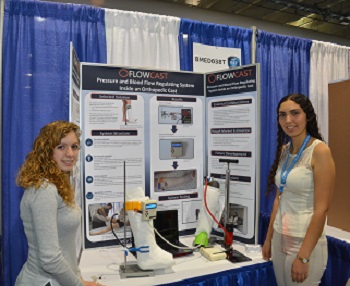Bones: Custom cushioning helps heal a bad break
For a patient with a broken limb, an inflatable bladder inside their cast could limit complications that can occur during healing

Two Israeli teens designed this inflatable bladder (white sleeve at right) to support broken bones as they heal inside an associated cast (left). A small programmable computer (box on cast) can adjust the air pressure inside the system to deal with swelling and other problems caused by ill-fitting casts.
Laura Buitrago/SSP
By Sid Perkins
PITTSBURGH, Pa. — Badly break a bone in your arm or leg and you’ll almost certainly get a cast. These sturdy sleeves of plaster or fiberglass are intended to hold the limb firmly in one position for a few weeks as the fractured bone heals. But costly or painful problems can develop, especially if the limb swells a lot after the cast has hardened into its final shape. Now, a pair of Israeli teens has come up with a solution that doesn’t require replacing the cast. They’ve developed a computer-controlled inflatable bladder to fit between the limb and the cast. Electronics monitor the pressure inside the bladder. As needed, they adjust how much air it holds to keep the liner’s grip on the limb firm but comfortable.
About 2 million people break limb bones in the United States each year. About half are severe enough to need a cast, say Betty Sharmaev and May Shoshan, both 17. These 12th graders attend ORT Greenberg High School in Kiryat Tivon. In a small number of cases, a limb may swell so much that pressure inside a cast slows down or totally blocks blood flow to the injured tissue. That can be very painful, says May. But it also can cause long-term damage to nerves and other tissues. It might even cause life-threatening blood clots, she notes.

But if casts were somehow adjustable, many of these problems — and their costs —could be avoided, the teens suggest. So, they came up with the idea for a balloon-like sleeve to line the inside of the cast and surround a broken limb. This air bladder can be inflated when a cast becomes loose, says Betty, to keep bones firmly in place. But when swelling becomes dangerously high, some air could be removed from the sleeve. A sensor inside the air bladder monitors the pressure inside the cast. Then a small computer keeps the pressure within the range that the doctor recommends.
Betty and May provided details of their research at the 2015 Intel International Science and Engineering Fair. This event was created by the Society for Science and the Public (which also publishes Science News for Students). The annual competition brought 1702 finalists here this year. They come from more than 70 different countries.
Betty and May built a prototype of their new system. It included the air bladder and the small programmable computer to control airflow into and out of the inflatable sleeve. The electronic equipment is lightweight and fits in a small box that can be easily mounted on the outside of the cast.
For now, the air bladder in their system has only one chamber. That means it’s like one big balloon, May explains. But future versions of the bladder might include several chambers, each with its own pressure sensor. That sort of design would be even more adjustable, says Betty. That might be useful when one part of a limb swells a lot but other regions don’t. A multi-chambered bladder also would let the teens include a “massage” function in their system. For short periods of time, the chambers could be inflated and deflated in sequence, pressing on the tissues and then releasing them.
With all of its benefits, the teens hope that their simple and largely reusable system will become a widespread part of treating broken bones.
Power Words
(for more about Power Words, click here)
bladder A flexible bag-like structure for holding gases or liquids.
cast A shell made of plaster, fiberglass or other hard material that encases a limb or large portion of the body, often to stabilize broken bones as they heal.
Society for Science and the Public (orSSP) A nonprofit organization created in 1921 and based in Washington, D.C. Since its founding, SSP has been not only promoting public engagement in scientific research but also the public understanding of science. It created and continues to run three renowned science competitions, including the Intel International Science and Engineering Fair (initially launched in 1950). SSP also publishes award-winning journalism in Science News (launched in 1922) and Science News for Students (created in 2003). Those magazines also host a series of blogs (including Eureka! Lab).
sensor A device that picks up information on physical or chemical conditions — such as temperature, barometric pressure, salinity, humidity, pH, light intensity or radiation — and stores or broadcasts that information. Scientists and engineers often rely on sensors to inform them of conditions that may change over time or that exist far from where a researcher can measure them directly.
tissue Any of the distinct types of material, comprised of cells, which make up animals, plants or fungi. Cells within a tissue work as a unit to perform a particular function in living organisms. Different organs of the human body, for instance, often are made from many different types of tissues. And brain tissue will be very different from bone or heart tissue.







